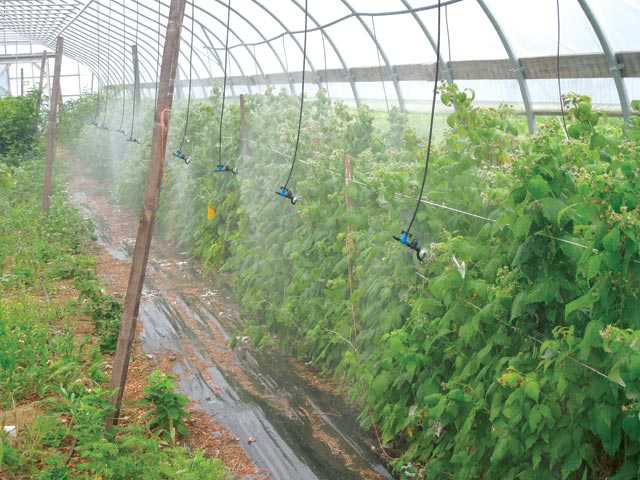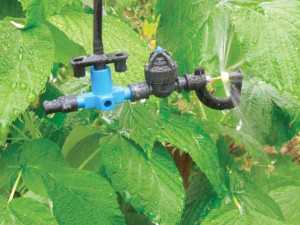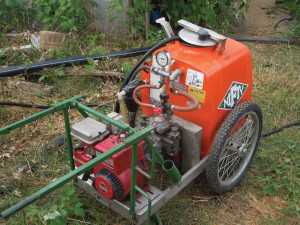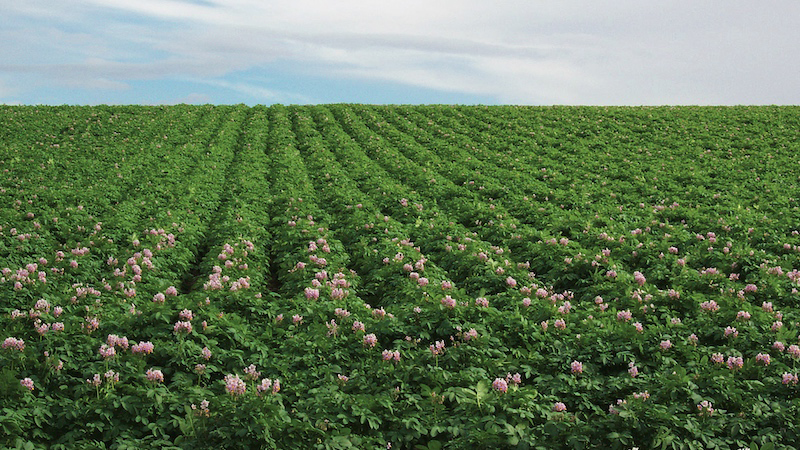Managing SWD In High Tunnel Raspberries

In the high tunnel raspberries, 3/4 inch irrigation tubing was attached to the structure, with 1/4 inch micro-tubing drop lines placed every 5 feet. (Photo credit: Cornell University)

More growers are adopting high tunnels for raspberry and other soft berry production, and seeing benefits in higher yields and extended harvesting. However, spotted wing drosophila has complicated the production of berries under high tunnels. Researchers at Cornell University are exploring the use of the solid set canopy delivery system, or SSCD, for use in high tunnel berry production.
“Fixed sprayer systems may be particularly cost-effective in high tunnels, as the framework to support the fixed lines is already present,” says Art Agnello, a Cornell entomologist. “A fixed sprayer system would save time in the application of insecticides compared with using conventional application equipment.”
Cornell’s research team, which includes Agnello, Andrew Landers, and Greg Loeb, installed the SSCD in high tunnels at three sites in New York. The team chose the high tunnel raspberries at Cornell’s New York State Agricultural Experiment Station in Geneva, NY; blackberries at the Cornell Horticulture high tunnels in Ithaca, NY; and a high tunnel raspberry operation at Stonewall Hill Farm in Stephentown, NY.
The Setup
For raspberries the research team attached a ¾-inch irrigation tubing to the high tunnel structure, and ¼-inch microtubing drop lines were placed every 5 feet along the row. The micro-tubing had an 8-millimeter opening with a flat, circular spreader with a 20-psi check valve. The nozzles faced laterally toward the center of the row to offer a vertical spray plane.

The microtubing had an 8-millimeter opening with a flat, circular spreader with a 20-psi check valve. The nozzles were pointed laterally toward the center of the row for a vertical spray plane. (Photo credit: Cornell University)
The micro-tubing drop lines were suspended every 2.5 feet for blackberries since the brambles were more vigorous than the raspberries. Researchers also added an additional supply line over the row center with drop lines placed every 5 feet.
Each line was operated for 30 seconds at 30 psi to cover the canopy. Agnello, Landers, and Loeb used a rotation of Delegate and Assail weekly at the end of July, with an additional 2 pounds of sugar per 100 gallons as a feeding stimulant. Mustang Max was also sprayed at the Stephentown site following the final Delegate spray at the end of September. The sprays were made at dusk to reduce exposure to beneficials, primarily bees.
After spraying was finished, the contents of the supply lines were gathered into a container and a backpack sprayer was used to treat adjacent high tunnels not outfitted with the SSCD. This was done to compare the effectiveness of SSCD over a backpack sprayer.

The irrigation lines were attached to an individual pressure gage and ball valve which was connected to a portable wheeled greenhouse sprayer. (Photo credit: Cornell University)
Gathering Samples
Greg Loeb gathered fruit samples in August in order to gauge the effectiveness of the treatments in SSCD. He noted that at the commercial site, there was no difference between using a backpack sprayer and the SSCD treatments, partially because fruit was harvested daily. There were approximately 2.5 times the flies found at the research plots than in the commercial site.
“At these sites, the ripening fruit was not harvested as frequently, and the Ithaca blackberry planting was much more vigorous, which resulted in spray coverage not being as thorough,” says Landers.
The research team used water sensitive cards to measure the effectiveness of SSCD at covering the canopy.
“Results show that spray coverage was highly variable, but predictably best on the outside of the canopy, and markedly better on the tops of the leaves than on the undersides,” says Landers. “Cards in the inside center of the canopy were less well covered.”
SSCD In High Tunnel Research Moving Forward
Agnello, Landers, and Loeb will be testing different spray rates and insecticide as well as spray durations to see if “the system is running too long and in effect washing off the active ingredient,” says Landers.
The research team will also consider using a tracer dye to assess spray coverage of the SSCD, adding center overhead lines in the raspberry high tunnels in order to boost coverage, examining positioning of canes and cane pruning in how they relate to canopy coverage, adding air-assist into the spray system, and testing pesticide residue levels on the fruit, and examining how pesticide efficacy changes over time.
“The availability of a fixed sprayer system could make growing high tunnel raspberries more feasible in the age of SWD. Fixed sprayer systems may also prove practical for smaller field plantings of high-value blueberries and raspberries, says Agnello. “The adoption of fixed sprayer systems for berry crops will reduce grower exposure to insecticides, as there will not be a need to travel through the planting to apply them.”
Funding for the SSCD project was provided by the New York Farm Viability Institute.
For more information on Cornell’s research on growing blackberries and raspberries under high tunnels, click here.










